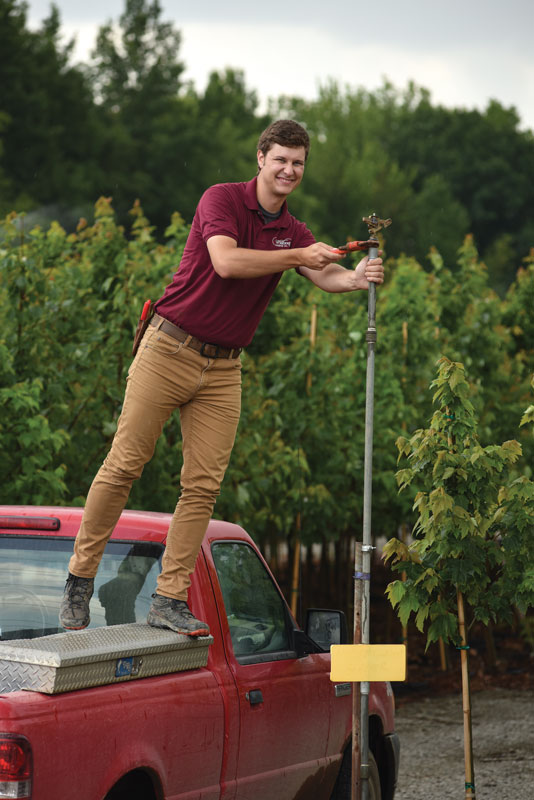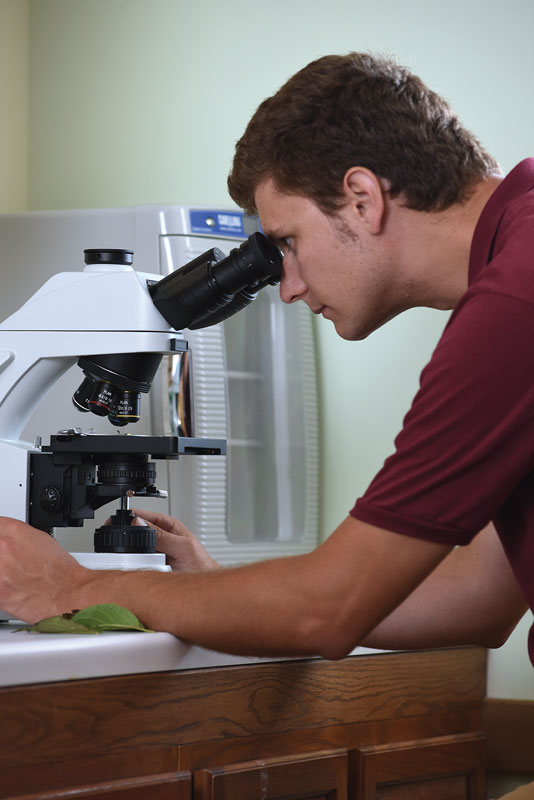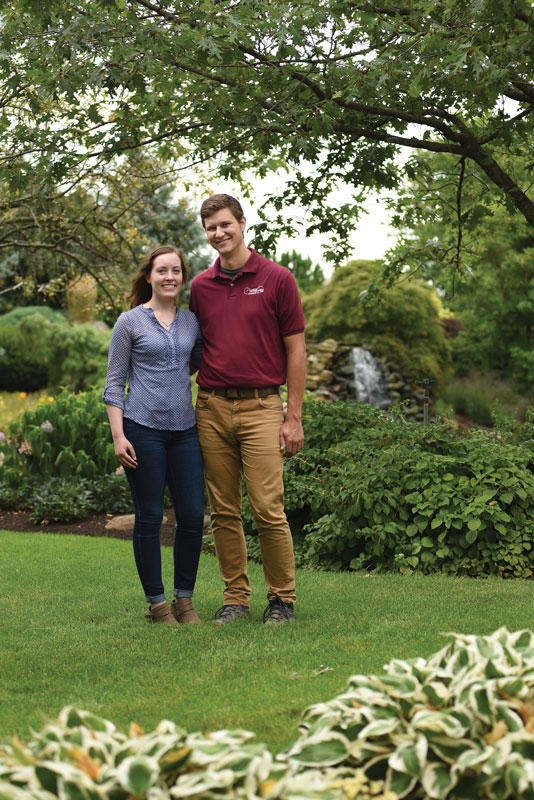9/1/2019
Beyond the Big Picture
Jennifer Zurko

John Terhesh doesn’t have a “comfort zone.” He doesn’t really need one. In fact, he would prefer not to dwell in one area, be it professional or
personal.
John’s willingness—actually his purpose—is to constantly try new things and devise solutions to problems, which is what’s helped him get to where he is in his career. It’s a career path with a few twists and turns, but that’s because when John was presented with a new opportunity, he just shrugged his shoulders and thought, “Sure, I’ll do that.”
The intern
Growing up in the southern suburbs of Chicago, John didn’t come from a horticulture background. He stumbled into the industry at the age of 15 simply because he needed a part-time summer job, and when he applied at the local garden center, they hired him.
He spent most of his time hauling bags of soil and watering the plants, which may not be the most inspiring story, but it laid the groundwork for him to have the bright idea of taking an Introduction to Horticulture class when he eventually went off to college.
During his first year at Southern Illinois University, John’s major was still undecided, but that Intro to Hort class was taught by an engaging professor who inspired him to want to pursue a B.S. in Plant & Soil Science with a minor in Agribusiness Economics.
“He tied all of the things I learned at the garden center together,” said John—so the iron was hot; it just need a few strikes of knowledge from a good mentor to get the fire going.
Now, the goal was to figure out what he was going to do once he was out in the real world. John’s first internship was at a landscaping firm, where he quickly discovered designing landscapes wasn’t for him. So he switched to the growing side of the industry by earning an internship at Ted’s Greenhouse close to his hometown. He worked there for a full season and “that’s when I really grew into the growing side of things,” said John.
The next year, John traveled to Avon, Ohio, for an internship at Willoway Nurseries and they liked him so much they hired him on as a full-time grower. He stayed on for three years and got the most knowledge and experience during that time. Also, while he was there, John and Karen Demaline (daughter of owner Tom Demaline) struck up a friendship and they were soon dating.
When John was offered a growing position at a nursery on the Wisconsin/Illinois border, he and Karen left Ohio. For five years, he was in charge of propagation for their entire container program from start to finish. It was sort of a baptism by fire because there wasn’t really a true training program; John had to learn everything himself through trial-and-error. It was challenging, but allowed him to see his true worth as a grower.
“You always question yourself on whether you’re good enough—I’m sure everybody does that,” said John. “But it was a little bit of a confirmation when we saw things improve. We doubled production and decreased the scrap [shrink] from 16% to 3%, so I had all the numbers to show I was doing well.”
And things were going well. John was going along swimmingly at his job, and he and Karen had made friends and were part of the local curling club (more on that later). Then one day, Karen’s dad Tom called and asked if they’d both like to come back and work at Willoway. Tom specifically needed help with hiring and training, and as John went through his own experience without much on-the-job training, he and Karen packed up and moved back to Ohio.
Thinking outside of the hiring box
When John started back at Willoway, he quickly realized that their current hiring process needed some improvements.
“Apparently, we hadn’t really been able to hire anybody for five years,” he explained. “At first, I basically did the standard thing—looked at all of the qualifications—and ended up with 20 people applying, five of them not getting past the interview stage. I started thinking, ‘This isn’t going to work.’ So I had to figure out another way.”
The first thing John did was look at how they were advertising job openings. It was pretty basic and didn’t make wanting to work at Willoway enticing at all. Granted, working in a nursery field or a greenhouse is hard, sweaty work, but John thought that if he took a different approach, he’d get more people to apply.
In the help-wanted ad, he talked about working at Willoway as “a new career,” that they were hiring for a “brand new position” and he changed the job description to more of a trainee position that allows for opportunities of upward professional movement within the company than the term “grower” does.
After these changes, Willoway went from getting maybe 20 applications for a position to over 200—and not just from people with a background in horticulture, but a variety of experiences and expertise.
“Now, when we do interviews, we hire people based on their personality and then we train them for the skills that they need,” said John. “So we’re picking someone who’s really a better fit for the department they’re going to be working in. We’re able to hire someone who really wants to work and build a career.”
 After John fixed how they get people interested in walking in the door, he came up with a whole new way to keep them there. He completely revamped Willoway’s new employee training program, which doesn’t just include where to punch your time sheet and the locations of the breakroom and bathroom. Every new trainee not only gets immersed in the job they were hired for, but they also spend a full week shadowing other staff from different departments—everywhere from shipping to sales to distribution. As someone who has a few internships under his belt, he considers it a mini internship.
After John fixed how they get people interested in walking in the door, he came up with a whole new way to keep them there. He completely revamped Willoway’s new employee training program, which doesn’t just include where to punch your time sheet and the locations of the breakroom and bathroom. Every new trainee not only gets immersed in the job they were hired for, but they also spend a full week shadowing other staff from different departments—everywhere from shipping to sales to distribution. As someone who has a few internships under his belt, he considers it a mini internship.
“This way, those managers can impart some of their wisdom on them and the new people get to know the employees, which I feel is a really important piece,” said John. “By the end of the week of their little ‘internship,’ they know people, they know who to ask if they have a question. And that’s a really big help.”
And they don’t get pushed into the deep end right away—each new grower gets a small section to run at first and it expands slowly from there until they’re comfortable. Even after the first part of the training is done, it continues for a few months, with veteran employees creating a list of things they still need to teach the new hire each week, while John meets with the newbie every Friday to check in.
John has found that multiple levels of training attracts good people, maintains their morale and productivity, and motivates them to consider future career development.
“I would say that with the way we hire, we end up hiring more motivated people,” he said. “So they seem to be always looking for something a little bit better. That’s the kind of level that we’re hiring. We get them very quickly trained up and they learn very fast and they start contributing very early. It’s a little bit time-consuming, but we feel that it’s worth it.”
John is quick to point out that this brilliant job training program wasn’t created his first week back at Willoway—he gathered feedback from previous employees who left shortly after, along with comments from new employees on how to better improve the training process. So John stepped back, took a look at how they could improve and changed it. And they’re constantly tweaking it based on employees’ suggestions.
John laughs and admits, “It doesn’t feel like a revolving door; we don’t really have people leaving after a week anymore. That hasn’t happened in a few years, so it’s been working fairly well.”
The ideas guy
It’s been three years since John has been back at Willoway, which is how long John and Karen have been husband and wife (they got married in Milwaukee right before they moved back to Ohio). And it was Karen who nominated John for the Young Grower Award.
One part she wrote on his nomination form stuck out to us: “John thrives on going against the grain. He combines his desire to make things better with his breadth of industry knowledge and sociable personality. He is a leader who is both technical and creative—he’ll start something from nothing and turn it into something big.”
The ability to be logical and creative at the same time makes John the ideal problem solver. If there’s an issue, and the solution isn’t immediately apparent, he’ll ponder different ways to fix it until it’s solved. He’s motivated by facts and science (which is the logical part of his brain), but is extroverted and adapts easily to change (which is the creative side). It’s impressive since not everyone can be both.
“I have to have a fairly high confidence level in what I’m doing before I take something on and that it’s going to work. And I like to stay flexible when I implement things; I don’t let setbacks become obstacles,” said John.
Being the friendly, ideas guy has been noticed by others outside of Willoway, too. John is very involved in the industry, serving on AmericanHort’s NextGen committee and on the board for the National Initiative for Consumer Horticulture (NICH). Regardless of your age or experience, John feels contributing to the industry outside of your daily role is vital.
“When people come in [to horticulture], they think it’s a smaller industry than it actually is, so things like Cultivate really expand people’s minds,” said John. “They look at all the technology and the companies that are doing innovative things at these shows and it broadens their horizons on what the possibilities are in our industry. Even if you’re coming from a small nursery and you’re part of this giant industry, it just opens up people’s minds to what they can do with their business.”

Always aiming for the button
John’s willingness to accept change and try new things makes him fearless—and I don’t mean the bungee-jump-off-a-cliff kind of fearless. He’s not afraid to take risks and is always up for new experiences. When he and Karen moved to Wisconsin they didn’t know anyone, but they heard that the sport of curling was really popular. Karen didn’t even know what curling was and when John looked it up he saw that there was actually a local curling club in their town.
“I said, ‘We’re going!’” laughs John, and they ended up being on a competitive curling team. (The subhead for this section is taken from a curling term.) It’s experiencing something new and different that motivates him.
“My wife and I are both like that. We like traveling, we like going to different places. We love traveling to Europe and going off the beaten path. I like seeing new cultures, trying different cuisines.”
Curling isn’t as big of a sport in Ohio, so John and Karen have taken up bowling in its place. And John plays soccer every week.
Moving forward in his career at Willoway, John is going to continue doing what he does best—come up with new solutions to problems, whether it’s an issue with hiring, pests, irrigation, logistics or anything else that’s needed. He’s a big-picture thinker with the day-to-day stuff, but as for the future, he takes it a year at a time.
John said he has an idea of the general direction of where he’d like to be someday, but for now, he wants to keep working on making his employer—and the industry—successful by contributing new ideas and pushing the boundaries.
“When people ask me, ‘Why do you love plants?’ I don’t know how to answer that,” John admits. “I do like them, but I think what drives me is constant improvement. It’s the science side of things. You’re dealing with a product that’s a living, breathing organism, and you can tweak or change things to make it live or die, and you don’t know what you did to cause that and you have to figure it out. You’re not dealing with widgets; you’re dealing with something that’s trying its hardest to live despite what you do. That’s what makes it cool.” GT